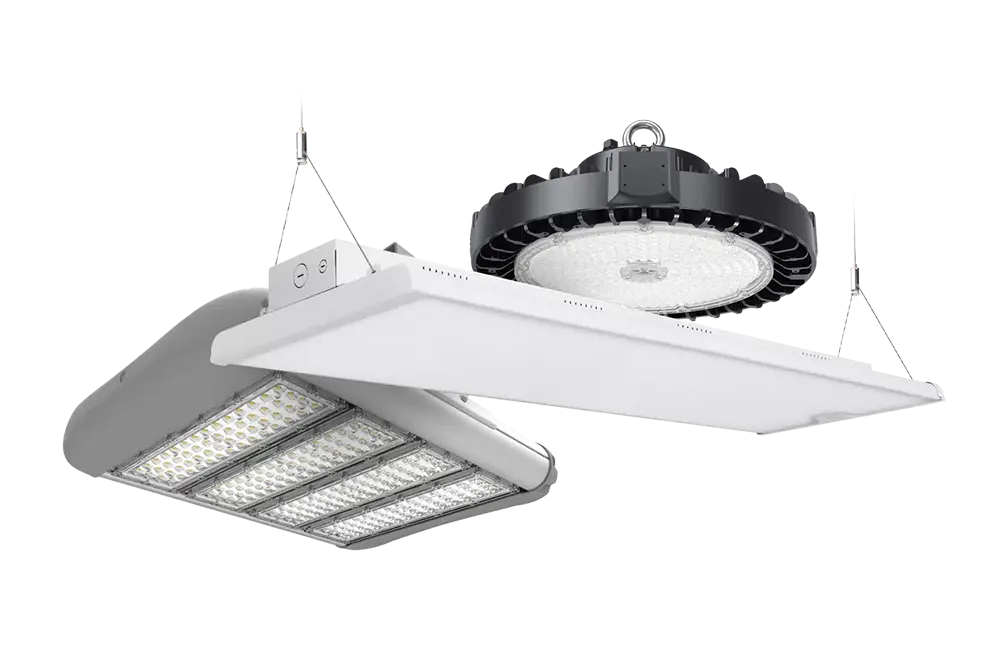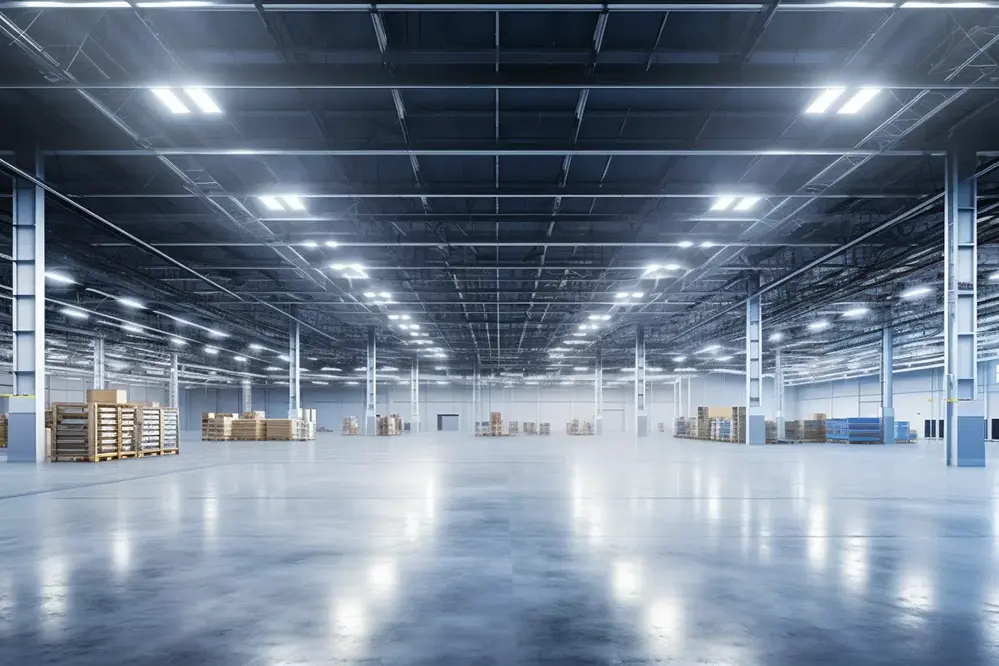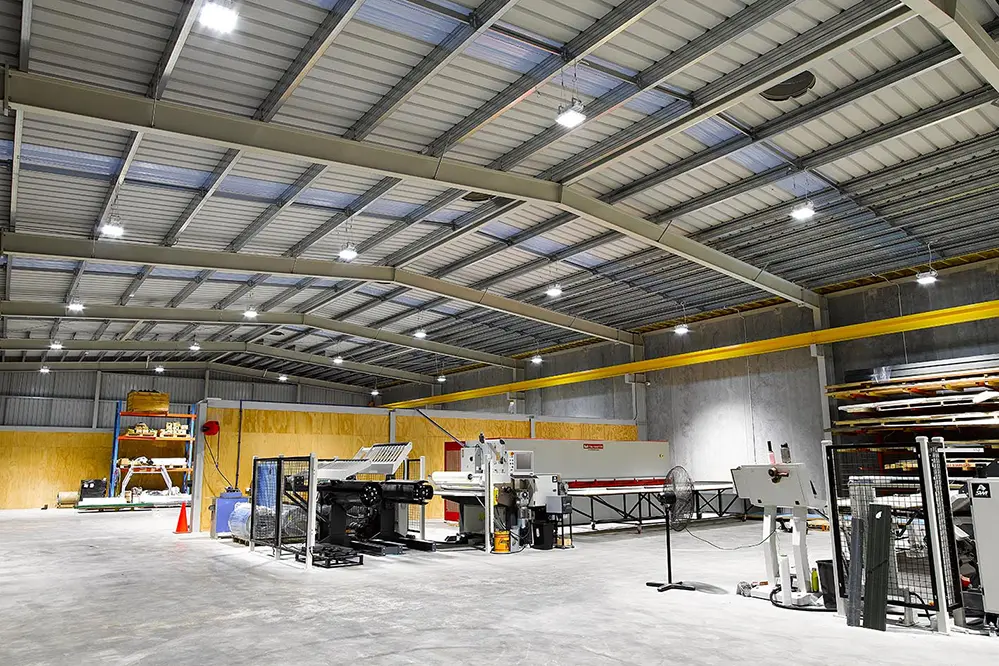In the bustling heart of an industrial factory, the hum of machines was a constant backdrop to the workers’ daily routines. However, it wasn’t until the factory manager decided to explore how to choose the right lighting for the factory that a remarkable transformation unfolded. The once dimly lit workspace was now illuminated with precision, leading to a noticeable boost in productivity and morale. This story is not unique; it underscores the profound impact that the right lighting can have on a factory’s operations.
The importance of selecting appropriate lighting for a factory cannot be overstated. According to a study by the American Society of Interior Designers, 68% of employees complain about the lighting in their workplaces. Poor lighting can lead to eye strain, fatigue, and even accidents, which can significantly hinder productivity. Conversely, well-designed lighting can enhance focus, reduce errors, and create a safer working environment. These statistics highlight the critical role that lighting plays in the efficiency and safety of industrial operations.
As we delve deeper into this topic, you’ll discover tips, best practices, and expert insights that will guide you in making informed decisions about your factory’s lighting. Whether you’re looking to improve energy efficiency, enhance worker satisfaction, or boost overall productivity, the right lighting choices can make all the difference. Join us as we explore the transformative power of lighting in the industrial sector.
Evaluate Factory Lighting Needs
Identifying your factory’s unique lighting requirements is crucial to determine the best solutions.
Firstly, consider what tasks your workforce regularly performs. The type of work and its specific demands will greatly influence the kind of lighting necessary, ensuring that each task is executed with precision and safety. Furthermore, assess if any areas require variable lighting conditions for different processes or shifts.
Adequate understanding of operational tasks is essential.
Begin by analyzing if specialized zones – be it production lines, quality check stations, or storage areas – have distinct lighting requirements to optimize worker performance at its fullest capacity. Additionally, consider implementing adaptable lighting solutions.
Evaluating these requirements will pave the way for implementing dynamic lighting systems. Such lighting systems can both adapt to the introduction of new equipment in the new year and respond to fluctuating demands across various shifts. This informed approach fosters an environment where innovation fuels productivity and reduces operational hurdles, emphasizing forward-thinking luminance strategies.
Consider Energy Efficiency
As you ponder how to choose the right lighting for your factory, prioritize energy-efficient lighting solutions such as LED, which minimize costs, reduce emissions, and offer longevity, all of which contribute to your overarching goal of sustainability.
Aligning energy-efficient choices with your factory’s values supports both the planet and the bottom line, empowering your enterprise to thrive responsibly and economically.
Analyze Cost-Effectiveness
Your strategic decision on lighting—particularly its cost-effectiveness—will dramatically impact both the short-term and long-term financial health of your factory.
LED lighting can cut energy costs by up to 80%, enhancing profitability while supporting sustainability goals.
By investing in lighting systems that balance upfront costs with long-term savings, you secure a fiscally responsible future. Consider not only initial installation expenses but also maintenance and operational efficiencies over time.
Implementing cost-effective lighting ensures that you’re investing in a solution that meets today’s needs and anticipates tomorrow’s demands, fostering a resilient and forward-focused enterprise.
Types of Factory Lighting

Various types of factory lighting offer solutions that cater to different operational needs, enhancing safety, task-specific requirements, and eco-efficiency. From LED, fluorescent, and high-intensity discharge to natural lighting, each option contributes to the fabric of your workspace’s environment.
Evaluating these lighting types allows factory leaders to optimize energy consumption and productivity while maintaining control over operating costs.
Ambient Lighting Options
Choosing ambient lighting for your factory is pivotal in ensuring both functionality and a conducive work environment. This foundational layer enhances visibility and creates a comfortable atmosphere for all workers.
- LED Panel Lights: Efficient, long-lasting, and adaptable to various settings.
- Fluorescent Tubes: Cost-effective with widespread use, ideal for general illumination.
- High Bay Lighting: Excellent for facilities with high ceilings, offering broad-area coverage.
- Natural Skylights: A sustainable option that reduces energy usage while providing natural light.
By integrating these options judiciously, you lay the groundwork for a well-lit, energy-efficient workspace. Each choice should align with both immediate lighting needs and future aspirations.
Having a strategic lighting plan not only boosts productivity but also supports a positive morale within the workspace. This can significantly uplift operational efficiency across your entire factory.
Task Lighting Solutions
Ensuring precise and effective task lighting can dramatically enhance productivity and safety in your factory environment.
- LED Task Lamps: Energy-efficient with adjustable arms for targeted illumination.
- Under-Cabinet Lighting: Perfect for shadow-free lighting in workstations.
- Magnification Task Lights: Ideal for detail-oriented tasks requiring enhanced visibility.
- Rechargeable Portable Lamps: Offers flexibility and mobility for changing needs.
- Adjustable Beam Spotlights: Suitable for specific tasks requiring focused light.
These solutions cater to diverse operational needs, offering clarity for intricate work tasks while reducing eye strain.
Carefully selecting task lighting can empower your workforce to maintain high-quality standards and precision in their operations.
This tailored approach not only bolsters efficiency but also ensures a safer, more adaptive workspace aligned with modern lighting ergonomics.
Understand Industrial Lighting Standards

Familiarizing yourself with industrial lighting standards is crucial to ensuring your factory meets safety, health, and well-being benchmarks. These standards specify the type, color, brightness, and light-distribution necessary to optimize your facility’s productivity.
These recognized guidelines, along with practical tips, help you design an effective lighting system that enhances both the ambiance and functional aspects of your work environment.
Compliance with Safety Regulations
Adhering to safety regulations is paramount when selecting lighting for your factory. Ensuring compliance minimizes risks and protects your workforce.
- OSHA Standards: Follow the Occupational Safety and Health Administration guidelines for adequate illumination.
- Emergency Lighting: Install compliant emergency lights that effectively guide employees during unexpected situations.
- Anti-Glare Solutions: Utilize lighting systems designed to reduce glare, enhancing visibility and comfort.
- Regular Inspections: Conduct frequent checks to ensure all lighting systems remain compliant with current safety standards.
Integrating these practices not only safeguards your workplace but also promotes a culture of safety and vigilance.
Choosing the right lighting further solidifies your commitment to maintaining a secure and efficient manufacturing environment.
Assess Lighting Distribution
When evaluating lighting distribution, a balance of uniformity, intensity, and adaptability, tailored to each task, proves vital. Carefully analyze how light interacts within your space, identifying potential shadows or areas where distribution might be uneven, ensuring tasks are performed under optimal conditions.
To enhance the effectiveness of a well-lit space, include factors like “reflective surfaces.” These can act as amplifiers of natural light, reducing reliance on artificial sources. It’s not just about the placement of the main fixtures, but also the integration of auxiliary sources that help achieve an evenly distributed glow conducive to productivity and employee wellbeing.
Minimize Shadows and Glare
Effective lighting design requires careful consideration of shadows and glare to ensure optimal productivity and safety.
In environments where precision tasks are a standard part of the workflow, minimizing shadows and glare becomes particularly crucial. By arranging lighting fixtures at strategic angles, shadows on work surfaces can be minimized, allowing employees to focus on precision tasks without unnecessary distractions. Additionally, diffused lighting and well-positioned fixtures prevent harsh direct light, reducing the potential for eye strain and enhancing visual comfort.
Moreover, selecting the right materials for work surfaces can further diminish light-related challenges. Surfaces with non-reflective or matte finishes help in minimizing glare, allowing workers to maintain a high level of focus and efficiency throughout their tasks.
Therefore, incorporating advanced lighting strategies that reduce shadows and effectively control glare will undeniably contribute to the seamless operation of your factory. Implementing these techniques fosters a positive work environment where employees can thrive, empowering them to excel and innovate. With the right approach, lighting can transform your factory into a beacon of efficiency and inspiration.
Choose Appropriate Light Intensity
In factory settings, the appropriate light intensity is crucial for ensuring both safety and productivity among your workforce.
Ideally, an optimum lighting strategy is a balanced interplay between ambient, task, and accent lighting, tailored to the specific needs of different workstations. Consider the tasks at hand, as delicate assembly lines might require brighter lighting than general storage areas. Consistent and well-measured lumens across these areas guard against fatigue and bolster concentration, reducing error rates.
Moreover, consider the benefits of a dynamic lighting system that allows for adjustable light levels. By incorporating dimmable fixtures, workers can adapt the environment to their individual preferences and according to time-sensitive tasks, enhancing both comfort and performance.
Most importantly, an intentional approach to lighting intensity not only streamlines workflow processes but also contributes to a culture of innovation. Proper light levels ensure that productivity shines at its brightest, propelling your factory to new heights of operational excellence. By championing thoughtful lighting design, you set an inspiring precedent for future-forward thinking in industrial environments.
Opt for Durable Lighting Fixtures
Durability is the cornerstone of reliable lighting.
In a bustling factory setting, lighting must endure various challenges. The lights need to withstand the daily rigors of an industrial environment, such as extreme temperatures, dust, and potential impacts or vibrations. Consequently, opting for the most rugged and robust fixtures is critical to ensure long-lasting performance and minimal maintenance disruptions.
These fixtures should be made from industrial-grade materials.
The high demands of factory operations necessitate fixtures that can weather the toughest conditions. Such lighting solutions are not merely about surviving the daily grind—they are about consistently delivering top-notch performance every single day.
By investing in durable fixtures, your factory secures uninterrupted illumination and minimizes the downtime associated with frequent replacements or repairs. This strategic decision not only guarantees sustained productivity but also embodies a commitment to sustainability and efficiency, empowering your factory to operate with unparalleled confidence and tenacity.
Implement Smart Lighting Controls
Incorporating smart lighting controls is a testament to embracing innovation, paving the way for enhanced operational efficiency. These systems can adapt to the dynamic needs of a factory environment, offering precise lighting adjustments to optimize energy usage and overall performance.
By integrating these intelligent systems, factories can achieve a “smarter workspace.” This is not just a matter of convenience but a strategic move towards sustainable operations. Over time, the combination of data-driven insights and automation leads to significant energy savings and enhances the safety and comfort of the work environment, fostering a thriving, future-ready factory.
Integrate Automation Technologies
Harnessing the power of automation technologies in your factory’s lighting system is pivotal for maximizing efficiency and sustainability, and offers the potential to achieve transformative results.
Automation enables real-time adjustments, ensuring lighting conditions are consistently optimal.
With the integration of automated solutions, factory lighting systems can be tailored to respond to external factors such as natural light, occupancy, and production schedules, thereby reducing energy consumption and operational costs while improving workflow and productivity.
The application of automation technologies extends to the seamless programming of lighting scenarios at different stages of the production process. By doing so, factories not only enhance operational precision but also create a holistic environment where innovation thrives. Automation acts as the “pulse” of a future-focused manufacturing setting, unlocking the full potential of intelligent lighting solutions.
Plan for Maintenance and Upkeep
Ensuring longevity and optimal performance, regular maintenance of lighting systems is vital to your factory’s success and sustainability.
Routine inspections should be incorporated into a comprehensive maintenance schedule that prioritizes system wellness, allowing for proactive measures to prevent issues. This strategy also extends the life expectancy of your lighting investments. Embracing this preventative mindset will not only mitigate operational disruptions but also foster an environment where your factory’s productivity remains uninterrupted.
Strategically, make use of a centralized database to track maintenance. On addressing these challenges, digital tools allow for quick assessments, thus enabling timely replacements and reducing downtime when servicing lighting components.
Systematic and efficient practices in managing lighting equipment will further enhance workplace safety, as well as ensure that luminance levels meet necessary standards. By delineating clear schedules and responsibilities, you place your factory in an advantageous position to reap the myriad benefits of a well-maintained lighting system—reducing costs, enhancing employee morale, and optimizing operational efficacy.
Explore LED Lighting Benefits
Harnessing the potential of LED lighting can revolutionize your factory’s energy consumption, cost efficiency, and environmental impact.
In addition, LEDs boast an impressive lifespan, often ranging between 25,000 to 50,000 hours, which translates to decreased maintenance requirements, further curtailing downtime and operational disturbances. The vibrant quality of LED lighting not only improves visibility but also contributes to enhanced safety and productivity in industrial settings.
With benefits like “energy-efficiency” and “sustainability,” LED lighting positions your factory for success in the modern marketplace.
Longevity and Performance
Choosing the right lighting can markedly improve both the longevity and performance of your factory operations. Efficient lighting solutions are essential investments that ensure consistent, reliable facility functionality.
Long-lasting lighting minimizes frequent replacements, reducing disruptions to your workflow.
When considering how to choose the right lighting for your factory, it’s pivotal to assess the endurance of the technology. Opting for durable lighting solutions like LEDs ensures sustained performance, promoting a stable and productive work environment.
An investment in quality lighting solutions is not merely about immediate operational efficiency but also about securing long-term sustainability and growth. By selecting lighting with proven longevity, you not only extend the life of your fixtures but also bolster your factory’s capacity to thrive. Trust in well-vetted technologies and you may find your facility not only keeping pace with current demands but also excelling amidst future challenges.
Evaluate Retrofit Options
Evaluate retrofit options by identifying energy-efficient technologies that align with your factory’s needs, thus maximizing productivity and reducing costs.
Incorporating retrofits, such as advanced sensor systems or LED fixtures, can breathe new life into existing lighting, providing an efficient alternative to complete overhauls and enhancing cost-effectiveness.
The terms “retrofit” and “upgrades” are often interchangeable in the context of modernizing the factory environment.
Sustainability and Environmental Impact
Incorporating sustainable lighting solutions not only reduces energy consumption but also minimizes your factory’s carbon footprint and enhances corporate social responsibility.
- Energy-efficient LEDs significantly reduce overall energy usage.
- Natural lighting integration decreases dependency on artificial light.
- Smart lighting systems ensure optimal energy utilization.
- Recycled materials in lighting fixtures promote eco-friendliness.
By choosing sustainable lighting, you set an example of environmental stewardship while boosting operational efficiency.
Such initiatives support compliance with environmental regulations, ultimately contributing to a healthier planet.
Seek Professional Guidance
Understanding how to choose the right lighting for your factory is pivotal in modernizing your operations effectively.
In recent years, global studies, such as those conducted by leading industry organizations, highlighted that seeking professional lighting consultancy can significantly optimize energy consumption. Experts possess the technical know-how to tailor solutions to your specific factory environment, ensuring maximum efficiency.
Expert consultants offer insights that go beyond merely illuminating spaces. They provide guidance on aligning lighting configurations with operational workflows, enhancing productivity, and securing substantial long-term savings.
Engaging the expertise of a seasoned lighting professional yields a spectrum of benefits, starting from compliance with safety regulations to realizing innovative lighting design principles that cannot merely be achieved through DIY approaches.
In summary, investing in professional guidance ensures your lighting choices enhance efficiency and foster a progressive manufacturing environment.
Conclusion
Choosing the right lighting for your factory is a strategic move that bridges operational efficiency with advanced technology, ushering in a new era of productivity and sustainability. This decision empowers businesses to create environments that enhance safety, focus, and morale, setting the stage for a thriving workplace.
By consulting with experts, factories can uncover transformative solutions that may not have been previously considered. These insights can lead to significant energy savings and workflow optimizations, ensuring that each lighting choice is a strategic investment in the factory’s future.
Ultimately, harnessing the right lighting transforms your factory into a beacon of efficiency and modernity. This approach not only supports sustained growth and innovation but also paves the way for enhanced manufacturing success, positioning your factory as a leader in the industry.





